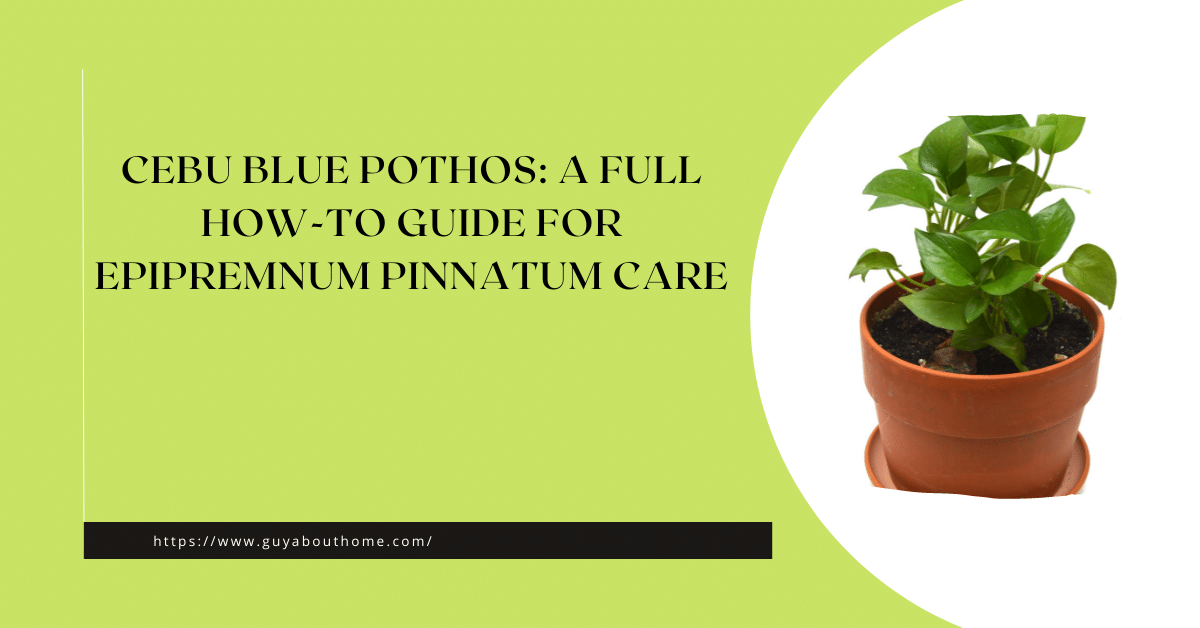Are you planning to grow an Epipremnum Pinnatum plant in your home and are wondering how to take care of it? Here’s a full care guide(applicable to cebu blue pothos)
Let’s discuss what Epipremnum pinnatum aureum plants are along with propagation and care tips here.
Thank you for reading this post, don't forget to the best blogger Guy About Home who offers the best garden and home improvement tips! If you are a home decor and design fan, don't miss the tips on home ideas. If you are a home garden owner, then you might be interest in our complete guides to house plants!
is epipremnum pinnatum a pothos?
Epipremnum pinnatum, or Pothos plants, are tropical vines that can grow easily indoors or outdoors with minimal care. They are versatile and can adapt well to various conditions. They also look very attractive in pots, especially in hanging baskets, and make great additions to your little jungle indoors.
Benefit From Caring A Epipremnum Pinnatum
Same as japanese monkey face orchids, pothos plants are not just mere decorations in your home. They also offer some benefits including the following:
- They are great air purifiers because they can absorb toxins from ambient air (e.g. they can absorb nicotine from the surroundings that their leaves become thrice more concentrated compared to tobacco plants)
- Some folks in Java, Taiwan, Bali, and Mindanao use them for teeth blackening
- Their roots are excellent materials for producing basketry of lampshades
- There are studies that have proven that Epipremnum pinnatum has antibacterial, anti-inflammatory, and anticancer properties.
- Traditional medicine applications include treatment for toothaches, malaria, diabetes, chest pains, skin diseases, joint pains, rheumatism, and fractures. Their barks are also used for back pain, muscular spasms, headaches, and wounds
What Is Epipremnum Pinnatum?
Pothos plants come in a few varieties. They have several common and scientific names, but the way you care for them is pretty much the same for all. If you want your Pothos plant to grow well and keep it healthy, familiarizing yourself with these plants would be helpful.
Pothos plants, including Cebu Blue Pothos, belong to the Epipremnum aureum species, similar to dischidia ovata, but they are known by different names:
Preferred Cebu blue pothos scientific Name
Epipremnum pinnatum
Preferred Epipremnum Pinnatum Common Name
Centipede Tongavine
Other Epipremnum Pinnatum Scientific Names
- Pothos pinnatus
- Scindapsus pinnatus
- Rhaphidophora pinnata
- Monstera pinnata
- Rhaphidophora aurea
- Scindapsus aureus
Other Epipremnum Pinnatum Common Names
- Dragon-tail plant
- Silver vine
- Taro vine
- Devil’s ivy
- Marble queen
- Golden pothos
- Blue pothos
- They are native to Asian countries like India, Malaysia, Japan, Taiwan, and China as well as in the Pacific Islands, Europe, and Northern Australia
Some common names are based on the plant’s characteristics. For instance, there are common names that are based on the plant’s leaf shape, color, or growth habit. Below are the main things that you should know about Epipremnum pinnatum plants:
- They are popular companions for Aglaonema, Fern, and Orchid plants.
- They are classified as environmental weeds and can spread by cutting, discarded plants, and/or plant fragments
- They mostly grow in temperate, tropical, and subtropical areas. They can appear along roadsides, in urban areas, rainforests, disturbed forests, and thickets
Mature Epipremnum Pinnatum: things to know
Is Epipremnum Pinnatum Fast to grow?
Epipremnum pinnatum is fast-growing vines that are highly invasive (they can engulf vegetation and shade out native shrubs and trees)
Not confident in planting an indoor plant? Why not getting power from our inspiring indoor plants quotes?
Is Epipremnum Pinnatum an indoor plant?
Epipremnum pinnatum is primarily indoor plants, but can also survive in outdoor environments
How Big Does a Cebu Blue Plant Get?
Cebu Blue, along with other Epipremnum pinnatum species, can reach between 4 to 40 feet in height. Like crispy wave fern, but when you grow them indoors, they might not even reach 10 feet. So if you want them to grow at their maximum height or length, grow them outdoors. With good watering practices and light, they can grow quickly up to a few feet in one summer.
Is Epipremnum Pinnatum Toxic?
Epipremnum Pinnatum plants are TOXIC. Put them in spots that can’t be reached by children or your pets. Common symptoms include redness, swelling, and pain which are usually found in the mouth. Rare symptoms are vomiting and difficulty breathing.
Features of Epipremnum Pinnatum Variegata
Below is an overview of the features of these plants:
- They are epiphytes that climb on rock surfaces or tall trees.
- Their stems are green, flexible, and cylindrical and can be up to 3cm in diameter
- Their leaves are green, glabrous, and alternating
- Young plants are creepers and will only start producing mature leaves when they have climbed enough heights
- Their first leaves (juvenile) can be arrow-shaped to elliptical and some have entire edges. Mature leaves are pinnately dissected and can grow from 30 to 50 cm in length.
- Some have pin-holes and white dots along the middle of their leaves. Others have windows in the blades of their leaves making them look like hoya pubicalyx varieties
- They have greenish spadices that are creamy-white inside.
- They bloom occasionally and don’t have specific flowering periods. They produce tiny flowers on canoe-shaped modified leaves (spadix) of up to 10 cm in length.
- They produce pure white blossoms that turn into creamy gray-green when they mature
- They bear fruits on their spadix that turn red when they’re ripe and contain sticky red-orange pulps with numerous brown seeds
Cebu Blue Pothos Mature: things to know
Pothos plants undergo two growth phases: Juvenile and mature. Each phase determines the color and size of the leaves as well as the plant’s growth behavior:
-
Cebu blue pothhos leaves
During the juvenile stage, the leaves are either bluish-gray or silver. Also, the leaves of the same plant can vary in shades like blue, silver, green, and bluish-green. These shades become more attractive and pronounced under bright light. Cebu Blue Pothos leaves become greenish when they mature.
How big and tall can cebu blue pothhos grow
Juvenile Pothos plants have oval or elongated leaves with a typical length of 2-4 inches. They have zig-zag divisions that go up the midsection of the leaves and look like the branches or fronds of palm trees. The leaves can reach up to 4 inches in length.
-
Growth Behavior
Immature plants are terrestrial. They can grow with little support from a caretaker. They can form sleek vines when planted in hanging baskets. Cebu Blue’s become natural climbers when mature.
Note: The details mentioned in this section are for indoor Pothos plants. If you grow them outdoors, they can grow multiple times than indoor plants would. For instance, outdoor Cebu Blues can have leaves of up to 30 inches
How to Care for Epipremnum Pinnatum (Epipremnum Pinnatum Care)
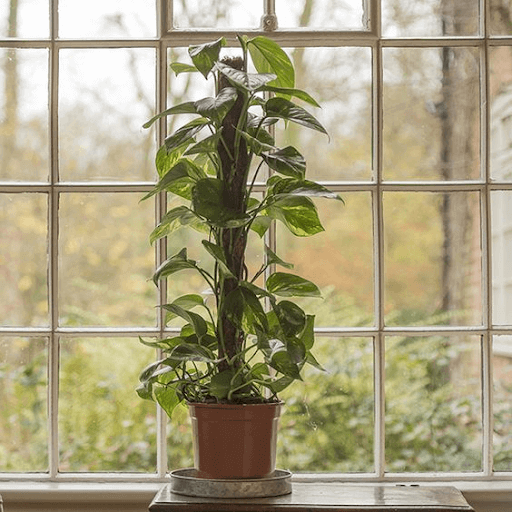
Source: Pinterest
Besides this plant, we also make a full care guide on how to care for Cereus Repandus.
Although Epipremnum pinnatum plants are easy to care for, you still need to give them proper care, especially if you grow them indoors. Below are some general Epipremnum pinnatum indoor care tips you can follow:
No worries! Though you might encounter the difficulties when learning how to care such an plant as a new plant caring starter, we got the most popular plant lover quotes that can partner with you and you are going to succeed in plant care and grow.
Cebu Blue Light Requirements
- Grow them in bright areas but not under direct sunlight.
- If you want them to grow faster and keep their leaves beautiful and vibrant, give them plenty of light.
- Occasional exposure to direct sunlight is fine but should be limited.
- The morning sun is ideal, especially during winters, but bring them in during afternoons.
Epipremnum pinnatum Watering
- Check soil dryness to determine if it’s time to water your plant.
- Water them once the top 2.5 to 5 cm of soil becomes completely dry.
- For pots or hanging baskets, press on the soil firmly. If it is dry, then water your plant. Otherwise, wait for the soil to dry more if you can still feel moisture.
- For watering, pour water in the basket/pot evenly and wait for it to drain out of the bottom. This is called deep watering which helps in nourishing the roots to avoid diseases.
Epipremnum pinnatum Humidity and Temperature
- Pothos plants are tropical plants so they need medium to high humidity. A 40% humidity level is ideal which is the case in regular households.
- The recommended temperature is from 18°C to 29°C (average room temperature).
- You can put the Pothos pot in a pebble saucer or tray to achieve optimal humidity. Just get any tray and put some pebbles or gravel plus water in it.
Epipremnum pinnatum Soil Mix
- Choose a light and well-draining potting mix that can still hold moisture. We recommend the following potting mixes:
- Equal parts of perlite, peat moss, and potting soil
- A chunky mix consisting of vermiculite or perlite along with orchid bark (NOTE: Vermiculite holds more moisture than perlite)
Make sure that the soil has good drainage to avoid excess moisture from damaging your plant. and be care for soil mite
Epipremnum pinnatum Fertilizing
- Although Pothos plants can grow on their own, fertilize them once a month in their growing season to help them flourish or grow bigger.
- If the soil already has slow-release fertilizers, you don’t have to fertilize them that much.
- Dilute plant fertilizers before applying them to your plant to lower the dosage strength.
- Do not fertilize them too much if they are not growing actively or during off-season.
- Stop fertilizing your plant during winter because Pothos plants grow slowly during these times.
Epipremnum pinnatum potting, repotting and pruning
- Trim off brown, dead, or decaying stems or leaves. The recommended time for pruning is during the spring season before the plant starts to grow vigorously.
- Hanging pots without support is not recommended because the plant will stay immature for a long time. It will not grow that much because it doesn’t have anything to grip on.
- Provide some moss support to the pot to give the plant something to climb on.
Cebu Blue Pothos Propagation: How-to Instructions
Besides this plant, we also make a full care guide on how to propagate Elatior Begonia.
Before the propagation process, make sure to sterilize your tools to avoid spreading diseases. Rubbing alcohol would be enough.
Cebu Blue Ptopagation Via Air Layering
You can propagate your plant using only one leaf:
- Cut a Pothos leaf including one node. A leaf node is the point of connection between the stem and the leaf.
- Get a small jar, put water in it, and then dip the entire stalk of the leaf in the jar.
- Keep the leaf upright and not completely drowning
Take note that although tiny roots can develop from the node, single-leaf propagation will still take longer compared to multiple-leaf cuttings.
Cebu Blue Ptopagation Epipremnum Pinnatum Cuttings
For cuttings, just cut a few inches from your plant and root them in water or soil. Soil propagation is simpler, but if you want to watch the roots grow, go for water propagation. First of all, make cuts that include at least two nodes before following the methods below:
Cebu Blue Ptopagation in Soil
- Bury the nodes under the soil.
- Make sure that the soil is humid and moist to allow the cuttings to propagate better.
Cebu Blue Propagation in Water
- Dip the nodes in water until you see root growth.
- Transfer the cuttings to a pot. Don’t wait too long before you transfer the cuttings because this will slow down the plant’s growth.
Common Epipremnum Pinnatum Care Problems &Tips
Besides this plant, we also summarize the caring issues and concerns on the plant Ficus Altissima.
Just like any other plant, such as aralia fabian, Pothos plants are not foolproof. Issues that you will often encounter with these plants include the following:
#1 Epipremnum pinnatum Stunted Leaves and Pest Attacks
Pothos plants are susceptible to common pests such as spider mites and mealybugs. Same as cattleya trianae, insect infestation can result in malformed leaves. Worst cases can cause stunted and distorted leaves.
You can use cotton swabs or damp cloth dipped in rubbing alcohol and then wipe the leaves with it regularly to avoid pest attacks. You can also spray your plant with pesticides.
#2 Epipremnum pinnatum Brownish Leaves
If the leaves of your plant look brownish, you might have exposed it too much to sunlight. Sunlight can burn the Pothos’ leaves. Another reason is overwatering or applying too much fertilizer. Make sure to manage the sun exposure of your plant and control the fertilizer you apply to it.
#3 Epipremnum pinnatum Yellowish Leaves or Unusual Leaf Shape
The last issue is leaf yellowing or unusual shape. Not enough light and water can cause the leaves to turn yellowish and become flatter than normal. The foliage might even look wilted which indicates that you are not giving it enough water. Uneven and over-watering may also be the possible causes. You need to water your plant regularly at controlled intervals to avoid these issues.
Epipremnum Pinnatum Varieties
Epipremnum pinnatum plant varieties are distinguished through the variegation type on their leaves. Just as begonia amphioxus, the most common types are listed below along with their key features:
Epipremnum Pinnatum Varieties #1 Cebu Blue Pothos
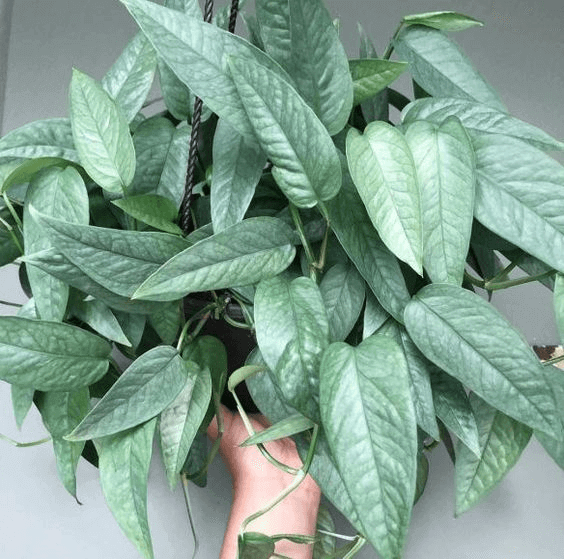
Source: Pinterest
- Heart-shaped and elongated leaves
- Shiny and silvery-blue foliage
- The foliage has veined patterns
- They can grow in bright, indirect sunlight as well as under high humidity levels and slightly moist soil
Find more cebu blue pothos care info if you are going to grow such an indoor plant.
Epipremnum Pinnatum Varieties #2Neon Pothos
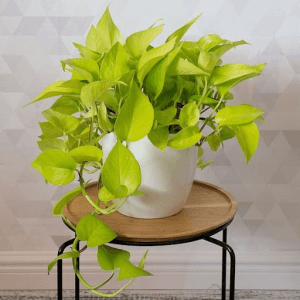
Source: Pinterest
- Bright green leaves that are almost translucent
- Bushy appearance
- Vigorous growers
- Perfect in containers on tall stands or hanging baskets
- They can grow in water
- Needs bright filtered light
- Only water it when the top one inch of soil dries up.
Epipremnum Pinnatum Varieties#3 Marble Queen Pothos
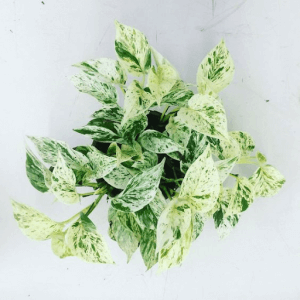
Source: Pinterest
- Mostly cream-colored and highly variegated leaves
- Eye-catching marble foliage
- Grows in a bright location with indirect sunlight
- It has a slow rate of growth so taking care of it is easier
- Requires less pruning because of its bushy appearance
- You don’t have to re-pot them often, unlike other Pothos varieties
Epipremnum Pinnatum Varieties#4 Golden Pothos: Cebu Blue Pothos varieties
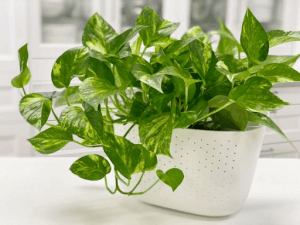
Source: Pinterest
- Light lemon-colored leaves with yellow variegation
- Patterns on the leaves are like brush strokes
- Its glossy leaves are ideal for brightening up shaded areas
- It can survive under low light
- They are good for bedrooms with limited light
- Clean air houseplant
Epipremnum Pinnatum Varieties#5 Jade Pothos: Cebu Blue Pothos varieties
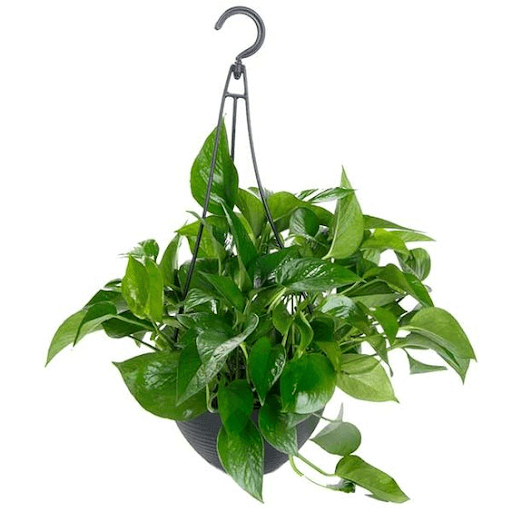
Source: Pinterest
- Dark green and heart-shaped leaves with slight variegation
- Also known as the devil’s ivy
- Dense foliage that you can prune to make a stunning tabletop plant
- Its stems can grow up to 3 feet long indoors
- It cascades elegantly from hanging baskets
- Great for providing vertical accents because they can climb on poles
- Grows in shaded, low-light, or bright light areas
- Excellent for bathrooms because they don’t require high humidity levels and much sunlight
Epipremnum Pinnatum Varieties#6 Glacier Pothos
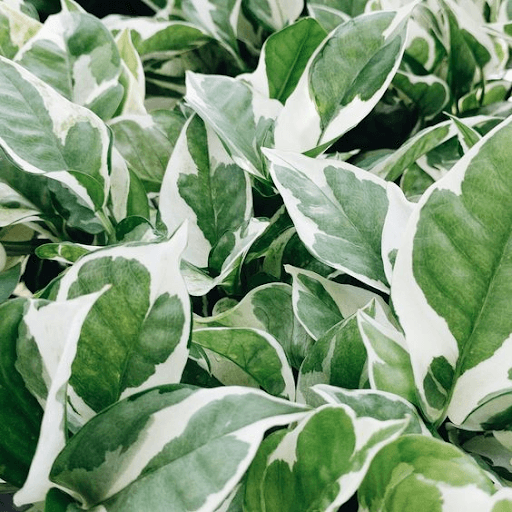
Source: Pinterest
- Bushy slow-growing plant
- Small heart-shaped leaves
- Green variegated foliage with gray and silver speckles
- Excellent for desks and table
- It can grow in low-light and normal room humidity conditions but it can grow faster in higher humidity levels and brighter light
Epipremnum Pinnatum Varieties#7 Pearls and Jade Pothos
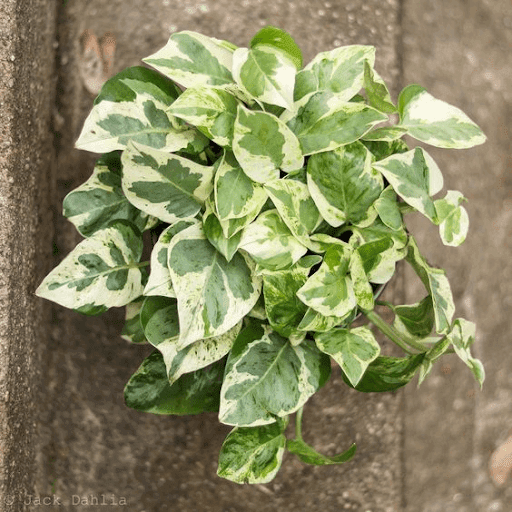
Source: Pinterest
- Also known as N’Joy pothos
- Small emerald green leaves with gray, white, and cream marking
- White and green variegation
- A slow-growing plant that is ideal for office desks or tabletops
- Its soil always needs to be moist. Otherwise, it will wilt.
- It is not partially drought-resistant like other types of pothos plants
Epipremnum Pinnatum Varieties#8 Manjula Pothos
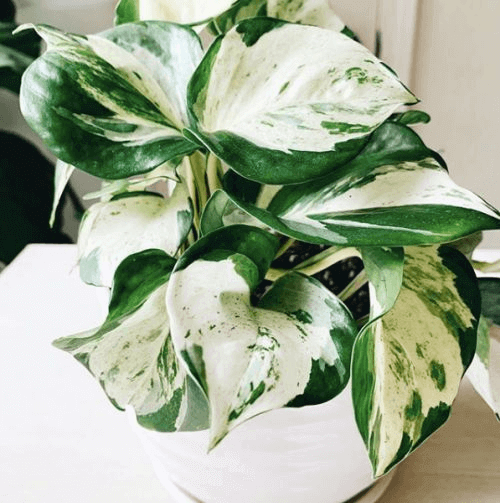
Source: Pinterest
- Almost white leaves with hints of green. Others have a white and green marbled effect.
- Also known as the happy leaf
- It is a very rare variegated variety of pothos, so it is difficult to come across
- Grows in bright locations with indirect lighting
- Its variegation fades when exposed to too much sunlight
Epipremnum Pinnatum Varieties#9 Jessenia Pothos
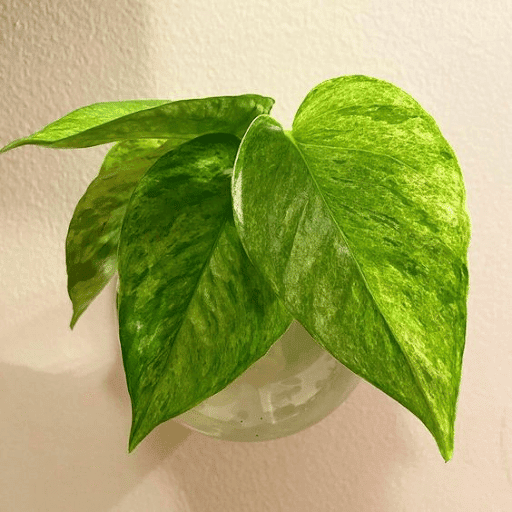
Source: Pinterest
- A new type of pothos plant that is becoming popular
- Emerald green leaves with lemon-yellow variegation
- Some variegated leaves have marbling effects while there are those that are almost golden yellow
- It is very rare and hard to find
Epipremnum Pinnatum Varieties#10 Hawaiian Pothos
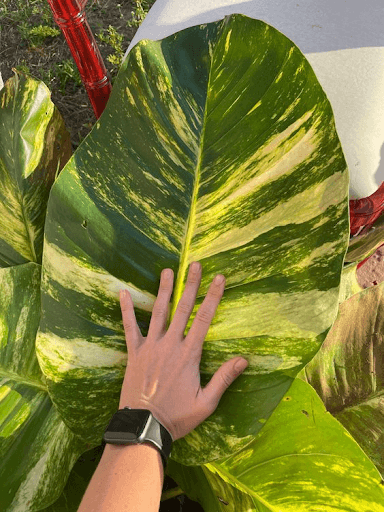
Source: Pinterest
- Huge leaves (larger than other Pothos plant varieties)
- Dark-green foliage with yellow variegation
- Its large leaves and long vines create attractive vertical accents
- They are great on poles and hanging baskets
- You can prune it to control its stem length and maintain a compact growth
Cebu blue pothos vs philodendron
Cebu blue plants is not a philodendron. The common philodendron varieties are
- philodendron prince of orange
- philodendron mamei
- philodendron burle marx
- Philodendron Hederaceum
- philodendron xanadu
- Philodendron Birkin
- philodendron gigas
- philodendron squamiferum
- philodendron camposportoanum
- painted lady philodendron
- philodendron cordatum
- philodendron brasil care
- philodendron rojo congo
- philodendron imperial red
- philodendron golden dragon
- philodendron white wizard
For more amazing ideas you can have, visit Guy About Home today or you can check the related blogs:
- How To Take Care Of Succulents
- The Ultimate Guide to Growing Tomatoes
- Your Complete Guide on How to Grow Potatoes – Everything You Need to Know
- The Top 10 Hanging Basket Plants
- 7 Plants You Should Plant In Perennial Hanging Baskets
For more step-by-step ideas, diy tips and guides, kindly visit the website guyabouthome.com providing the best garden & home improvement tips.


